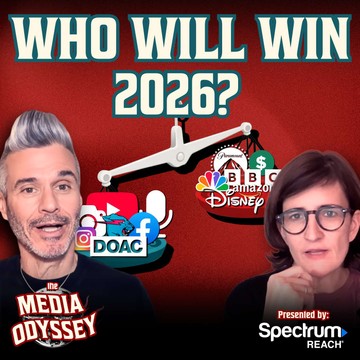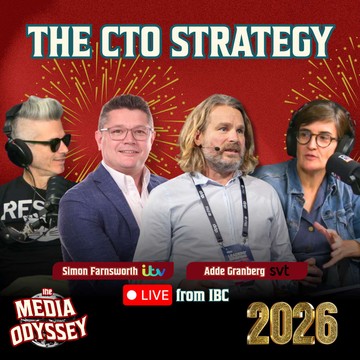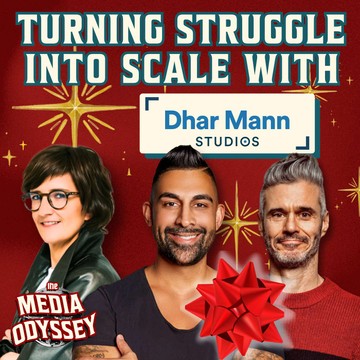

The Media Odyssey
Evan Shapiro & Marion Ranchet
Each week, two of media’s most influential thinkers, Evan Shapiro & Marion Ranchet, take on the hottest media topics with their hottest takes, helping their audience chart a course through the maelstrom that is today’s Media Odyssey.
Based in the US, Evan Shapiro is the Media Industry’s official Cartographer, known for his well-researched and provocative analysis of the entertainment ecosystem in his must read treatises on Media’s latest trends and trajectories.
Marion Ranchet, French expat based in Amsterdam, has become the industry’s go-to expert in all things streaming, building a following for turning even the most complex problems into easily digestible and actionable insights.
Ranchet and Shapiro are known for their sharp-yet-accessible content on Media consumption, audience trends, and the shifting fundamentals of the business itself. Even during the toughest of topics, they each make talking about Media fun. Together every week, these two will offer entertaining, often humorous, and always educational content on today’s Media Odyssey.
Based in the US, Evan Shapiro is the Media Industry’s official Cartographer, known for his well-researched and provocative analysis of the entertainment ecosystem in his must read treatises on Media’s latest trends and trajectories.
Marion Ranchet, French expat based in Amsterdam, has become the industry’s go-to expert in all things streaming, building a following for turning even the most complex problems into easily digestible and actionable insights.
Ranchet and Shapiro are known for their sharp-yet-accessible content on Media consumption, audience trends, and the shifting fundamentals of the business itself. Even during the toughest of topics, they each make talking about Media fun. Together every week, these two will offer entertaining, often humorous, and always educational content on today’s Media Odyssey.
Episodes
Mentioned books

Jan 8, 2026 • 51min
WHO WILL WIN 2026?
Media faces another challenging year with layoffs and fragile advertising markets. Success will hinge less on content volume and more on discoverability and distribution strategies. The generative AI bubble is expected to correct, impacting valuations and practices. Political advertising is projected to surge in connected TV, demanding better targeting. Watch for new European media CEOs leading transformative efforts while M&A activity heats up amidst regulatory scrutiny. Ad-free viewing is predicted to decline as integrated advertising becomes ubiquitous.

Jan 1, 2026 • 46min
REGIFTED: THE CTO PLAYBOOK FOR SURVIVING FRAGMENTATION
Simon Farnsworth, CTO at ITV, and Adde Granberg, CTO at Sveriges Television, discuss the transformation of public broadcasting in a digital-first world. They emphasize the shift from 'doing digital' to 'being digital,' highlighting the importance of cloud and AI in scaling production. The conversation reveals how outdated mindsets hinder broadcasting's evolution, advocating for collaboration with platforms like YouTube and TikTok. Both guests illustrate how innovative technologies, such as 5G and generative AI, can revolutionize content creation while reducing costs and environmental impact.

Dec 25, 2025 • 47min
REGIFTED: TURNING STRUGGLE INTO SCALE WITH DHAR MANN
Dhar Mann, an entrepreneur and founder of Dhar Mann Studios, shares his journey of overcoming personal struggles to revolutionize independent media. He discusses the significance of structuring stories as hero journeys for emotional impact and how data-driven production enhances creativity. Dhar reveals his approach to scaling a vertically integrated studio while promoting authentic storytelling. He emphasizes the necessity for creators to embrace their struggles, turning them into unique narratives, and discusses future expansions into nonfiction and podcasts.

Dec 18, 2025 • 49min
FRONTLINE PUTS PBS ON YOUTUBE
Raney Aronson-Rath is the Executive Producer of Frontline and Editor-in-Chief of Documentaries at GBH, known for spearheading its digital transformation. In this discussion, she emphasizes that public media must adapt by utilizing platforms like YouTube to thrive and attract younger audiences. Raney highlights how YouTube extends reach without replacing traditional broadcasting. She also outlines Frontline's innovative strategies, including simultaneous releases and a focus on global distribution to ensure impactful storytelling amidst a struggling media landscape.

Dec 11, 2025 • 57min
GRADING 2025: WERE WE RIGHT?
The hosts assess their 2025 predictions, shining a light on YouTube's rise as the top TV channel and Netflix's bold partnerships, including deals with TF1 and Spotify. They explore how creators are now central to mainstream culture and reflect on the stagnation in the CTV landscape. The duo dives into the dual nature of AI’s influence, delivering backend improvements while hype drives valuations. They also address the challenges ahead in the job market and share career advice for those facing layoffs.

Dec 6, 2025 • 21min
BREAKING NEWS: Netflix x WBD
In a surprising twist, Netflix emerges as the leading bidder for Warner Bros. Discovery, igniting discussions on the financial implications and political backlash. California officials may pose the biggest roadblock, complicating approval. The potential acquisition threatens to overshadow mid-budget films as focus shifts to blockbuster franchises. Compounding the situation, HBO Max's international rollout faces chaos amid merger uncertainties. The hosts delve into the broader impact on Hollywood's landscape and the future of streaming.

19 snips
Dec 4, 2025 • 52min
FANDOM > AUDIENCE
Holly Graham, Chief Commercial Officer at Little Dot Studios, and Ben Arnold, SVP of Commercial Operations, dive into the evolution of modern media, focusing on fandom and audience engagement. They reveal how Little Dot operates over 1,000 channels with a super-fan strategy to authentically engage audiences. The duo shares insights on case studies featuring Gordon Ramsay and Prime Video, highlighting the importance of trust and creative experimentation. They argue that digital success flows from listening to fans and embracing diverse revenue streams beyond ads.

19 snips
Nov 26, 2025 • 28min
BBC STUDIOS + YOUTUBE A PARTNERSHIP CASE STUDY
Pedro Pina, a YouTube executive overseeing EMEA operations, teams up with Jasmine Dawson, SVP of Digital at BBC Studios, to discuss a groundbreaking partnership. They explore how YouTube amplifies global fandom and enhances traditional media, debunking myths about platform competition. Jasmine shares insights on turning BBC properties like Bluey and BBC Earth into fan-driven ecosystems. They emphasize the need for an audience-first approach, the value of creator collaboration, and the importance of experimentation in today's media landscape.

Nov 20, 2025 • 46min
FLYING WITH THE EAGLES
Jen Kavanaugh, Senior VP of Marketing for the Philadelphia Eagles, shares insights on modern sports fandom that transcends game day. She emphasizes how Eagle's culture is nurtured through year-round storytelling, creating emotional connections with fans. Jen reveals how the team transformed its locker room into a relatable ensemble, involved in global brand outreach with initiatives in Australia and beyond. Her approach to measuring fan engagement sidesteps vanity metrics, focusing instead on meaningful interactions that strengthen community bonds.

Nov 13, 2025 • 49min
TUBI PUTS CREATORS IN THE SPOTLIGHT
Rich Bloom, General Manager of Tubi's Creators Program, discusses the groundbreaking creator-first strategy of the streaming service. He explains how Tubi transforms creators into media startups, emphasizing ownership and creative control. Bloom highlights partnerships with popular figures like Kevin Hart and the importance of niche fandoms. He shares insights on rapid production timelines, creator revenue models, and the platform's unique ad strategy. Tubi's focus on empowering creators signals a new era where traditional and creator media converge.


